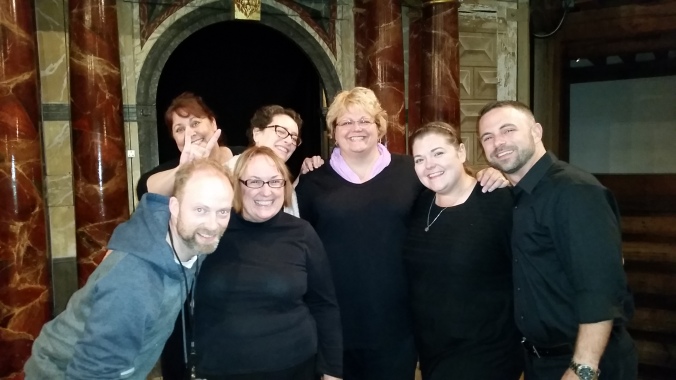As I stated in my previous post, I had a blast learning about Shakespeare pedagogy this summer. But I was already a Shakespeare devotee before this experience, and I’ve been performing as an actor/musician for most of my life, so it was sort of a given that I would tremble with a frisson of delight and wonder at regular intervals during the course of the three weeks. That said, I wasn’t awarded a generous scholarship from the English Speaking Union so that I might go and have a personally fulfilling experience — it was granted to me that I might bring knowledge back to share with my students and my colleagues. The programme, after all, is called Teaching Shakespeare Through Performance.
How, then, will my teaching be different this year?
Something the teaching artists and practitioners at the Globe stated on several occasions was that the exercises and theatre games we were playing were all born of the rehearsal room: vocal exercises meant to consciously connect the voice with movement; activities to help us embody archetypes to enhance performance; the encouragement to play the words completely differently than you did before. “We do this in preparation for all the shows here,” they told us. We weren’t made to do watered-down versions of of the actor’s practice, we were treated as professional actors.
This ethos the first thing I will bring back to my classroom: I’m going to treat my students like they’re professional actors. This seemed to help even the most reticent performers among us to break through the fear.
So did the scaffolding. This is edu-speak for the way you build your lessons toward a final objective or goal, and it’s the aim of every educator in the course of our unit development to structure lessons so that each bit of information and each activity builds on what came before. The educators at the Globe taught us ways to scaffold Shakespeare so that a student who felt totally stupid confronting his words for the first time (which is most of us, really) could be performing his works with total comprehension in a very short time.
How?
Start small. Don’t give students the entire intimidating text right away. Build up to it. Pull short, specific scenes to use with certain acting exercises and expand the students’ comfort zone. Don’t be afraid to cut text to fit your students’ needs — don’t rewrite or change words, but remove the parts that are confusing, then reintroduce them in time. Help them towards early success with a text so that they won’t feel as resistant to it as you go.
Once you’ve got a chunk of text you can work with, there is any number of exercises you can do with it, many of which can be found in Creative Shakespeare by Fiona Banks. Fiona was our programme director and she took us through many of the activities in the book as if we were the students. I won’t go through all of them, but here’s one that I’ll definitely do with my students and will likely do with other teachers when I run professional development workshops.
In the book it’s called “Adam’s 10 Point Plan to Performance” (p. 174-184) and — in an extremely condensed description — it works like this. You assign students into two groups and give each group a text with multiple roles (we used the thumb-biting quarrel from act one of Romeo and Juliet, cut so that young students could understand it). Once the students have arranged themselves in a circle and assigned themselves roles, they proceed to read the text in a variety of ways and from a variety of positions around the room. Each reading brings something new out of the performer, whether it be a sense of the rhythm of the words, the emotional value, their relationship to the other characters and the audience, appropriate movement. By the tenth reading of the passage, your students will have created a fully-staged scene without realizing that’s what they were working towards all along.
This is just one of very many activities, techniques and strategies that we’ve been given to bring to the classroom, and the list could go on for many more blog entries than anyone would care to read. Suffice it to say, this was one of the best professional development experiences I’ve had. There are still several weeks to go before school starts back in New York, and I’m almost wishing it would get here sooner so that I could get started putting into practice everything I’ve learned.
Teaching Shakespeare Through Performance has given me not only the courage but the savvy to produce A Midsummer Night’s Dream with our drama club this year — my first time directing a Shakespeare play. This, of course, means my drama classes will study it so that they’re prepped to see it; my hope is that by the end of the unit they’ll wish they had auditioned because it will be so much fun. My English class will study Measure for Measure (as part of a semester exploring the concepts of Justice and Mercy, which, incidentally, was my plan before I learned that this was also the theme for the Globe’s season. Synchronicity!) and Henry V (which we’ll see at BAM in April — I hope!). Most years I’ve taught only one Shakespeare play and usually slogged through it as a chore; this year we’ll take on three and I absolutely cannot wait — that’s how confident TSTP has made me feel!
So: confidence, know-how, strategies, activities, passion, fun.
That’s what I’ll be bringing back to the classroom.

love that Emily and I are working on our PD session and googled Adam’s 10 pt plan and this came up!
LikeLike
Huzzah!!! I love that, too! Good luck!!
LikeLike